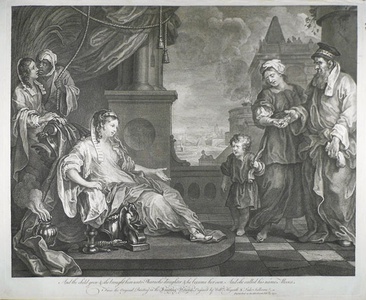| Method | Copper engraving and etching |
| Artist | Luke Sullivan after William Hogarth |
| Published | From the Original Painting in the Foundling Hospital, Engrav'd by Willm,, Hogarth & Luke Sullivan. Published as the Act directs Feb.y 5 1752. [J & J Boydell c.1795] |
| Dimensions | Image 388 x 505 mm, Plate 425 x 525 mm, Sheet 470 x 645 mm |
| Notes |
A scene in the heroic historical style of the infant Moses being presented to the daughter of Pharaoh. The original oil-painting was donated to the London Foundling Hospital, established in 1741 by Captain Thomas Coram to educate and maintain orphans and abandoned children. Hogarth himself was a founding Governor of the hospital, and, owing to his own childlessness, fostered a number of the Hospitals wards in his own home. The subject matter of the scene was appropriate for the aims of the new institution. Pharaoh's daughter, seated on an ornate chair and wearing a kindly expression, gestures gently to the young Moses, who clutches at his nursemaid's clothes in fear. The nursemaid, actually his own mother, accepts money from a steward. In the background a Nubian whispers in anxiety to one of the handmaids. The scene is decorated with numerous Egyptianizing motifs, including a smoking incense brazier, a distant skyline of pyramids and other architectural fantasies, and even a small, grimacing crocodile that crawls from under the throne. A quotation (Exodus 2.10) inscribed below the image reads: 'And the child grew, and she brought him unto Pharaohs daughter, and he became her son. And she called his name Moses.' Luke Sullivan (1705 - 1771) was a London-based Irish engraver and miniature painter. He was supported in his early career by the Duke of Beaufort, his father having worked for the Duke as a groom. His best known works were completed as an assistant to William Hogarth, though Hogarth was reputed to have had difficulty working with Sullivan, owing to the latter's erratic behaviour and frequent absences. Later in his career he worked on engravings of various British views, including that of Stonehenge for Grose's 'Antiquities of England and Wales,' as well as having some success as a miniaturist with the Society of Artists. William Hogarth (1697 - 1764) was born in London, the son of an unsuccessful schoolmaster and writer from Westmoreland. After apprenticeship to a goldsmith, he began to produce his own engraved designs in about 1710. He later took up oil painting, starting with small portrait groups called conversation pieces. He went on to create a series of paintings satirising contemporary customs, but based on earlier Italian prints, of which the first was The Harlot's Progress (1731), and perhaps the most famous The Rake's Progress. His engravings were so plagiarised that he lobbied for the Copyright Act of 1735, commonly referred to as 'Hogarth's Act,' as a protection for writers and artists. During the 1730s Hogarth also developed into an original painter of life-sized portraits, and created the first of several history paintings in the grand manner. Paulson 193 iv/iv Condition: Excellent impression with full margins. Water stain to left sheet edge, tear to left sheet edge. |
| Framing | unmounted |
| Price | £200.00 |
| Stock ID | 38128 |

